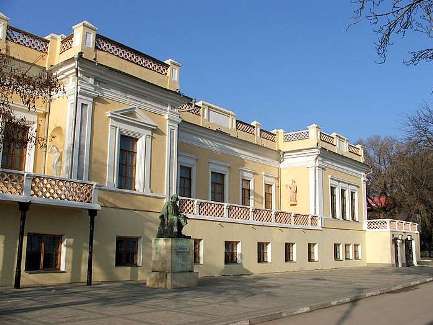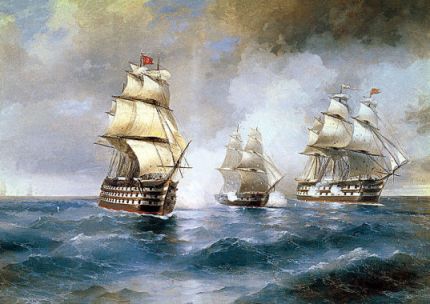

Location: Feodosiya

The Feodosia Museum named after I. K. Aivazovsky is one of the
largest museums of marine painting in the world and the memorial
house of the outstanding Russian artist I. K. Aivazovsky. It has
more than 13 thousand exhibits related to Aivazovsky, his artistic
tradition and time. Located in the city of Feodosia (Crimea). It
occupies two buildings - the house of Aivazovsky with the main
exposition and the main depositories of the museum (Galereinaya St.,
2) and the mansion of the artist's sister E.K. Mazirova, given over
to exhibition space and scientific and administrative needs
(Galereynaya St., 4). It is considered one of the most popular
museums in Crimea. In terms of the influx of tourists during the
season, it is often compared with the Italian Uffizi Gallery.
Since March 12, 2021, it has been closed to the public due to
major repairs and restoration of historical buildings. The opening
is scheduled for 2022.
The birth of the gallery is associated with 1845, when
his first 49 works were exhibited for public viewing in part of the
large mansion rebuilt by the artist on the Feodosiya embankment. At the
same time, the Aivazovsky school of painting began to operate there.
In 1880, the space of the house expanded - an additional building
was added for the exhibition hall. The gallery became the first museum
of one artist in the Russian Empire and the third public cultural place
after the Hermitage and the Rumyantsev Museum.
After the death of
Aivazovsky in 1900, the gallery, according to his will, became the
property of the city.
In 1921 it was nationalized.
The
gallery has a collection of about 13 thousand works of maritime
subjects, including the world's largest collection of works by I. K.
Aivazovsky (416 works).
The exposition of the gallery introduces
the work of Ivan Aivazovsky, the history of his family, the history of
the gallery itself. Valuable items of the Aivazovsky family are
exhibited in the safe room.
In the neighboring building - the
house of the artist's sister - paintings by Aivazovsky on mythological
and biblical themes, works by foreign marine painters of the 18th-19th
centuries, contemporaries of the great artist, representing the
Cimmerian school of painting - M. Voloshin, L. Lagorio, K. Bogaevsky,
students of Aivazovsky - M. Latri, A. Fessler, A. Kuindzhi, works of
Soviet artists.
At the end of 1920, the Feodosia department of
the Cheka, the naval and divisional special departments of the Red Army
and the Red Navy were located in the gallery building. During their stay
in the gallery building, a number of paintings were damaged.
In
1922, the premises were renovated, and on December 17, after an
eight-year break, the gallery, as the State Museum of the USSR, again
received visitors. The first director of the Aivazovsky Gallery was the
artist and art critic Gerasim Afanasyevich Magula. He organized in
Feodosia and the district the collection of art treasures left by the
emigrants, and on the basis of them he organized the Museum of Art
Treasures in the living rooms of the building, which lasted until 1925;
visitors got acquainted with works of applied art (porcelain,
silverware), antique furniture, and weapons. Already in 1923, N. S.
Barsamov became the director.
In 1930, a monument to Aivazovsky
by the sculptor I. Ya. Gintsburg was erected in front of the gallery
with the inscription “Feodosia to Aivazovsky”.
During the fascist
occupation of the Crimea, the art gallery was evacuated to Yerevan by
the heroic efforts of the gallery's director, Nikolai Stepanovich
Barsamov and his wife Sofya Barsamova. First, the paintings were
transported from Feodosia to Novorossiysk, and from there to Krasnodar.
There an order was received to bring the paintings to Stalingrad.
Violating the order, Nikolai Stepanovich, having previously secured an
invitation from Armenia, decides to take the paintings to Yerevan. While
the paintings were in Krasnodar, an exhibition was launched there.
Subsequently, exhibitions were organized in Yerevan itself. In November
1944, the art gallery was returned to Feodosia. There were no casualties
during the evacuation.
S. A. Barsamova left her memories of the
last days of her stay in the evacuation: “They saw us off very
touchingly. The commandant of the Yerevan gallery, Pashik, invited all
museum workers to send off the Barsamovs. Never before or since have we
been seen off with such warmth and sincerity. Having received the wagon
in which our boxes were placed, having received rations, which we then
ate for a year, having received medicines in case of illness, we said
goodbye to kind people, to hospitable Yerevan and set off on our way
back.
During the years of fascist occupation, Aivazovsky's house
was badly damaged by shells and machine-gun bursts. Since the end of
1944, repair and restoration work began in the buildings of the gallery
and the surrounding area. And in May 1946 the museum welcomed visitors
again.
In the post-war period, the gallery's storage was
repeatedly replenished. Aivazovsky's memorial hall was opened, telling
the story of his family and keeping family values. The museum was
equipped with a lecture hall and conference space.
In 1980, the
Feodosia Art Gallery named after I.K. Aivazovsky was awarded the Order
of Friendship of Peoples.
Currently, the gallery is not only a
museum, but also a scientific and educational center of the southeastern
Crimea. Within its walls, international art conferences, classical music
festivals, exhibitions are regularly held, a large research and
publishing activity is carried out.
Currently, the gallery has collected unique works of
seascape painting, graphics, archival documents and photographic
documents, memorial items and objects of decorative and applied art -
more than 13 thousand exhibits in total (according to the gallery's data
for 2021). The basis of the collection of the main building of the
gallery is paintings and drawings by I. K. Aivazovsky - 417 works (the
world's largest collection of his works). The most famous among the
exhibited works are “Brig Mercury attacked by two Turkish ships”,
“Sevastopol raid”, “Ship “Maria” on the North Sea”, “Georgievsky
Monastery”, “Sea. Koktebel”, as well as the largest painting by
Aivazovsky “From Calm to Hurricane” (212 by 708 cm).
In an
additional building, the mansion of the artist's sister E.K. Mazirova,
paintings by Aivazovsky on mythological and biblical themes, as well as
works by grandchildren, students and contemporaries of Aivazovsky - L.F.
Lagorio, A.I. Fessler, M.P. Latri, A.V. Hansen, K.F. Bogaevsky, M.A.
Voloshin, N.S. Barsamov, A. Kuindzhi, - as well as artists of the XX-XXI
centuries.